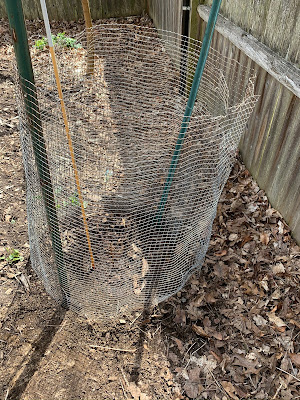 |
| False aster roots ready to plant |
I’m still expecting to receive most of my new pollinator plants from Garden in the Woods, the native plant center in nearby Framingham. I’ll need an appointment to pick up my plants with appropriate social distancing, and I’m still waiting to hear when that will be. These locally native plants won’t be bare root, but they’ll come with a low carbon cost for transportation.
Garden in the Woods didn’t offer false aster (Boltonia asteroides), though, which is why I connected with Prairie Moon. Once I was on their website, I was intrigued by other native perennials they offered and expanded my order.
 |
| One of the intriguing natives was early meadow rue (Thalictrum dioicum)-photo |
The plants arrived as plump packages of peat moss in thin plastic bags.
 |
| Minimal plastic involved |
Each species was packed in just one bag: five wild strawberries (Fragaria virginiana) were together in one package. Several of the labels included a diagram showing how deep to set the bare root plant in the ground. I was surprised to learn, for example, that the apparent crown of a early meadow rue was to be buried an inch beneath the soil surface.
 |
| Planting instructions |
On a sunny afternoon, I identified the planting sites and surveyed my defensive materials. I was looking forward to seeing the roots develop into young perennials, but that wouldn’t happen if our puppy dug them out of their holes. Fortunately I had a leftover roll of chicken wire and another of hardware cloth—wire fencing with half-inch openings.
First I tucked the false aster into its prepared spot next to the garden pond. It should be safe inside the fencing enclosure I’d built for it last week. I watered it well and wished it success.
 |
| False aster as safe as I could make it |
Next I planted the coralberry (Symphoricarpos orbiculatus) near the back fence where this vigorously spreading shrub will have room to expand. I surrounded it with a ring of hardware cloth wired to two metal stakes. If that doesn’t protect it, I’m out of ideas.
 |
| Coralberry in a wire cage |
The remaining perennials needed a different approach. White trout lily (Erythronium albidum) I planted in a moist, shady spot near the bird bath, covering the planting area with chicken wire. I anchored the chicken wire with sturdy two-pronged earth staples and attempted to disguise it with a layer of pine needles (Visual camouflage probably doesn’t fool dogs, I know).
 |
| If white trout lilies survive, they'll be glorious-photo Fritz Flohr Reynolds |
I gave the same treatment to a section of a bed off the deck, where I planted the wild strawberries and three wild geraniums (Geranium maculatum). There I tried for extra security by sliding the edge of the chicken wire under a bluestone paver I use as a stepping stone.
 |
| Wild geranium-photo David J. Stang |
Now I’m waiting to see whether my arrangements are dog-proof. Here’s hoping!

















